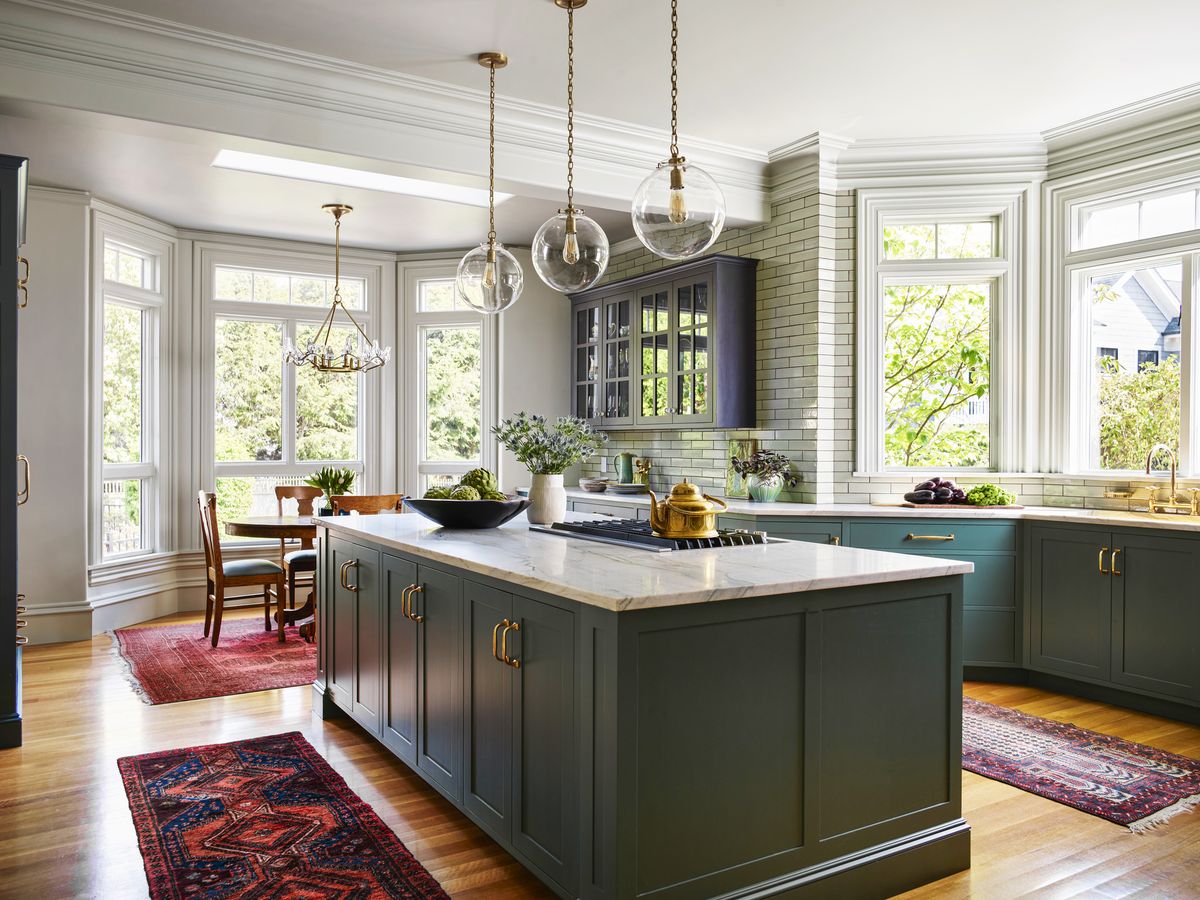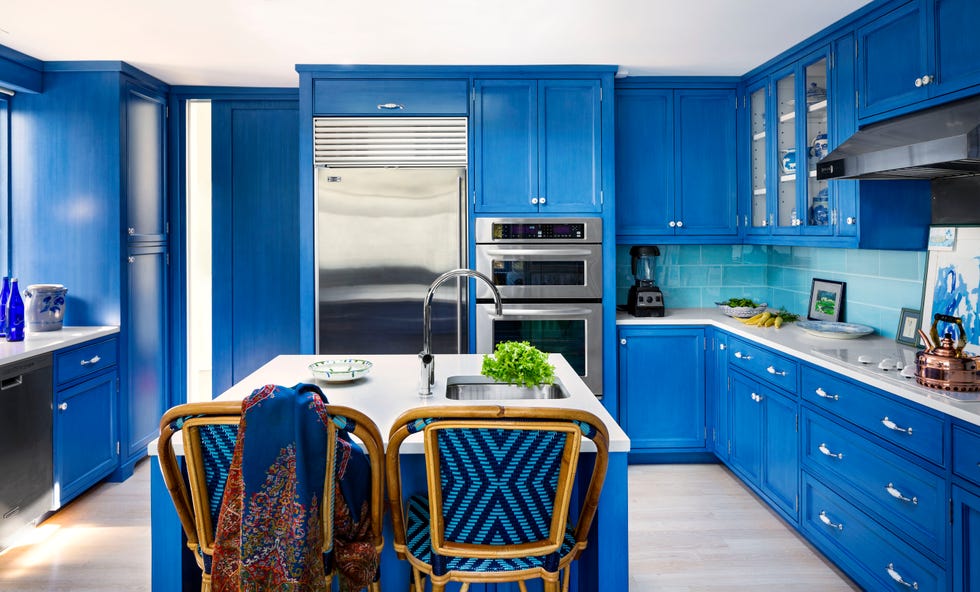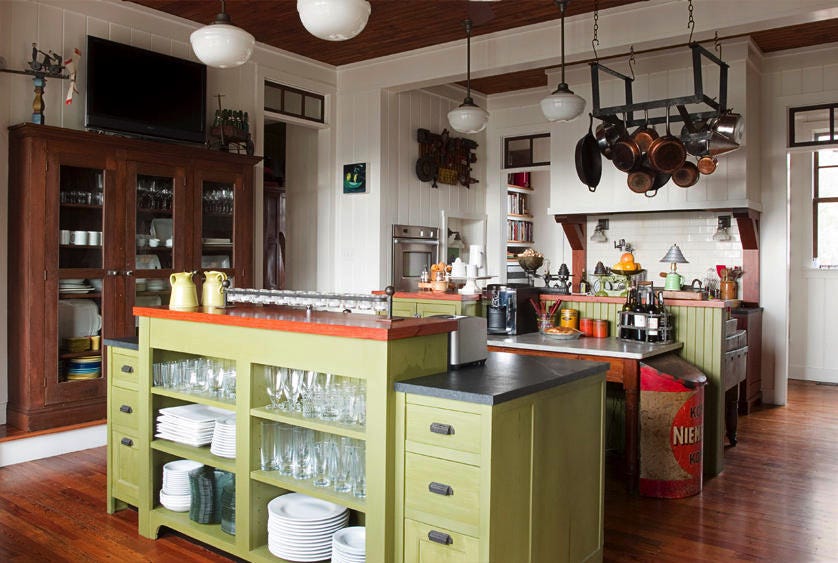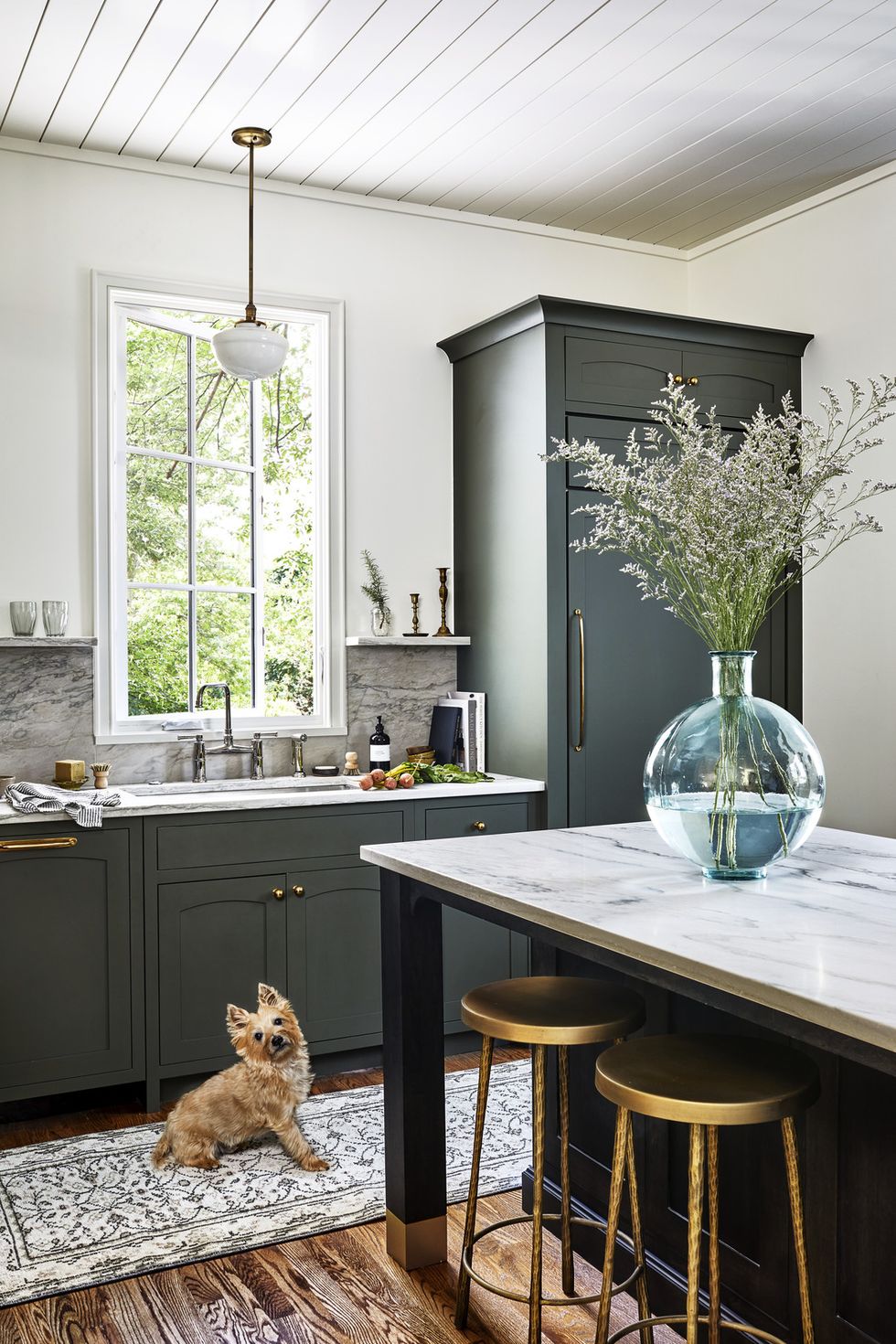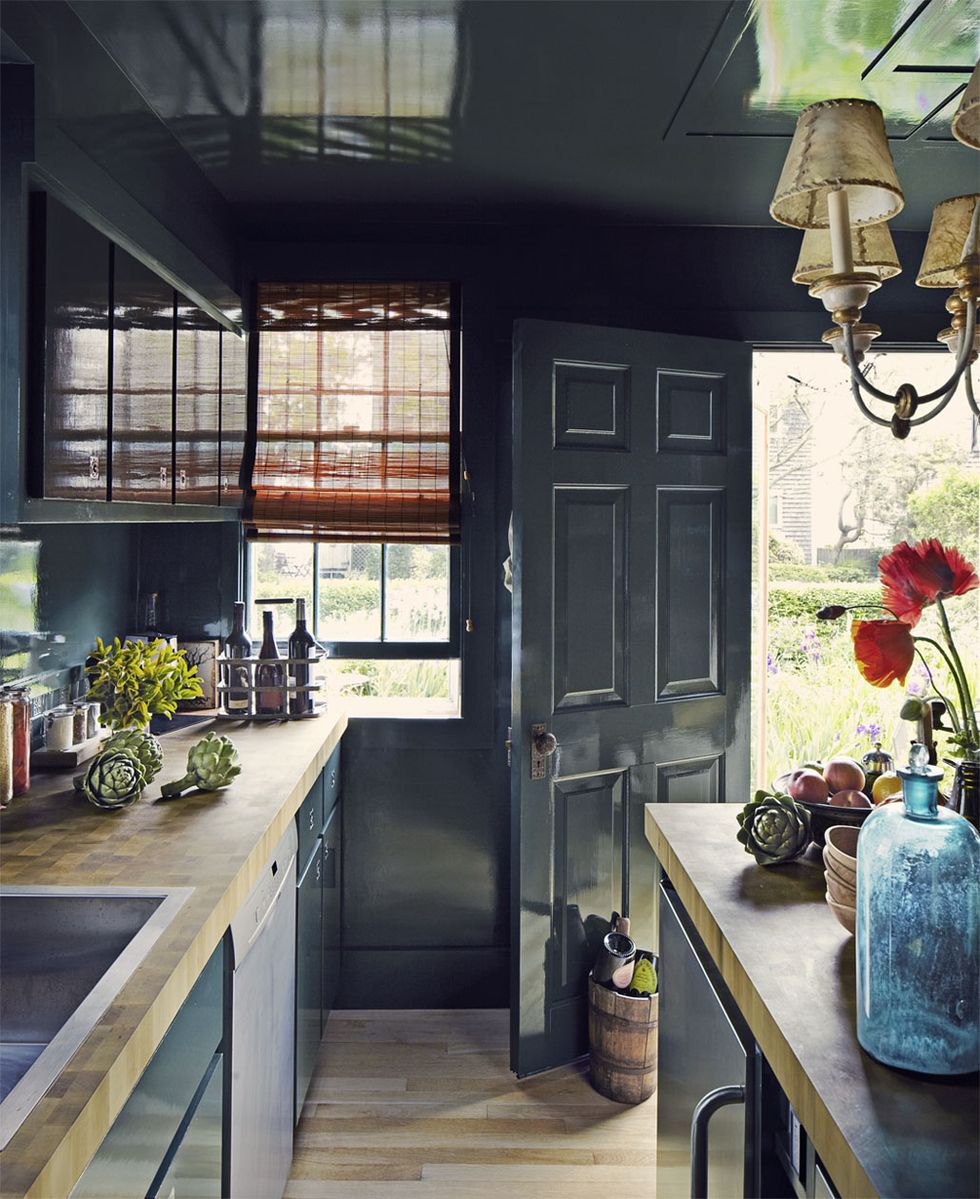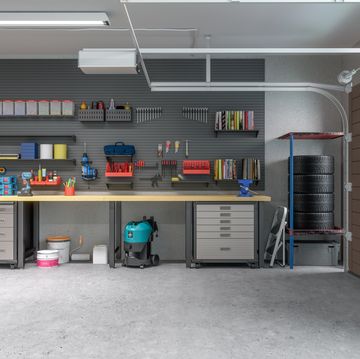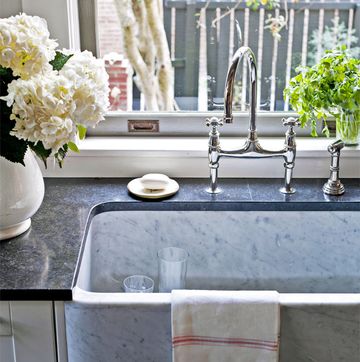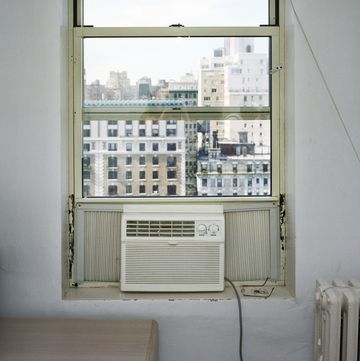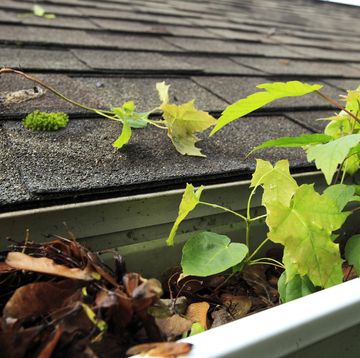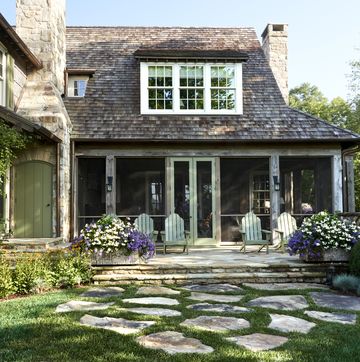Jump to:
White kitchen cabinets may still reign as the number-one choice for homeowners, but spend any time on Instagram—or page through the latest issue of House Beautiful—and you'll see colorfully painted kitchen cabinets everywhere. From inky blues and rich greens to deep, moody, of-the-moment purple or any one of our favorite kitchen paint colors, painting your kitchen cabinets is a great way to add instant personality and charm. You can even opt for a two-tone color palette to spice things up. Luckily, deciding how to paint kitchen cabinets is the trickiest part of this particular renovation project.
Painting kitchen cabinets yourself is easier than you might think. Going with a professional painter is always a great option since it practically guarantees high-quality results, but it's budget-friendly to DIY your painted kitchen cabinets. All it takes is a few easy steps and a bit of elbow grease. As with many home improvement projects, what you'll save in money, you'll spend in time—but with our easy guide to painting your kitchen cabinets, the end result is going to be totally worth the extra effort.
Below, we're taking you through each and every step—from purchasing the right paint to reassembling your space—to help you achieve expertly painted kitchen cabinets in just one weekend (okay, maybe two).
Cost To Paint Kitchen Cabinets
How much it costs to paint kitchen cabinets ranges drastically depending on how much help you need to hire and how big your space is. Generally, if you're looking for someone to come in and professionally spray your kitchen cabinetry with a new coat of paint, you can expect to spend anywhere from $5,000 to $8,000 and occasionally a bit more depending on the complexity of the job. This hefty (but worthy) price tag explains why many homeowners opt to tackle painting themselves—it significantly cuts down on costs.
Though you'll need to buy many of your own supplies for the project (more on that later), painting your kitchen cabinets should cost in the ballpark of $500, give or take, plus the cost of a massage afterward. (We kid, we kid—this is going to be fun, promise).
Choosing the Best Kitchen Cabinet Paint
You have two main options when it comes to selecting paint for your kitchen cabinets (and by this we mean paint type—we'll leave the color up to you!): oil or latex. Each has its own perks and pitfalls, which we'll dive into a bit more below.
Oil Paint for Kitchen Cabinets
Oil paint is a go-to pick for many cabinet painting pros. It goes on incredibly smoothly and boasts excellent coverage, allowing you to cover tough surfaces (like dark wood or painted cabinetry) with fewer coats than you might otherwise need. Oil-based paint dries more slowly but also cures (aka hardens) more quickly and—some would argue—provides a more durable, long-lasting surface for kitchen cabinets, which see a lot of wear and tear.
That's not to say oil-based paint is without its pitfalls, though. It's incredibly difficult to clean up (you'll need a chemical like turpentine or mineral spirits to clean your tools as well as any spills or messes), and many caution against the heavy fumes that oil paint gives off, both while you're painting and over time. Never used oil paint before? It may take a bit of trial and error to figure out the right technique for your kitchen cabinets. If you choose an oil-based paint formula for your kitchen cabinets, make sure you do plenty of research ahead of time when it comes to properly handling and disposing of the formula.
Latex Paint for Kitchen Cabinets
Because latex paint is the most popular type on the market, chances are you're already pretty familiar with it. Latex is a very forgiving water-based paint, meaning application and cleanup are a breeze. (Just use a synthetic bristle brush and clean it with mild dish soap and water). It dries more quickly and keeps its true color for longer than oil-based paint does, though it does take longer to cure, which can leave it susceptible to nicks and dents for a few weeks. Prep work is super important when you're working with latex paint, especially if you're coating your color directly onto a bare wood surface. You need to make sure to sand, prep, and carefully seal the wood before applying latex paint, or you could find your project chipping and swelling in a few short weeks.
Should You Paint Cabinets With a Brush or a Sprayer?
But wait! There's one more choice to make before you paint your kitchen cabinetry: brushing versus spraying. Both methods have pros and cons. Many professional painting teams rely on paint sprayers to paint kitchen cabinets because they give you a smooth, flaw-free application faster. However, there's a major learning curve when it comes to using a paint sprayer properly; it's not like a spray paint can. You'd either need to buy your own sprayer or rent one from your local hardware store. Another factor to consider? All the prep work that goes into spraying your kitchen cabinets. You need to mask off everything in the nearby area (including appliances, floors, and windows) with plastic sheeting to prevent overspray from tinting areas where no color is intended. This step alone can take several hours to a day. If you're a weekend warrior, you know that's precious time you could be making painting progress on your cabinets instead. In general, it's a good idea for novice painters to paint their kitchen cabinets by hand using a brush and roller.
Prepping Your Kitchen Cabinets for Painting
As with many DIY projects, the quality of your kitchen cabinet paint job depends largely on doing all the right prep work. Start by taking all your cabinet doors and drawers off their hinges and putting the hardware into labeled zip-top bags for easy reassembly (it's also a good idea to label the doors themselves so you don't get confused as to which one belongs where). Tape off any appliances or spots where the cabinetry meets wall or tile with painters tape so you end up with crisp, clean lines. Finally, lay down a drop cloth or floor protection paper to catch spills and spatters. All set? Great. Now you're ready to prep the cabinets themselves.
Step 1: Clean and Sand Your Cabinets
Whether you're starting with a stained wood finish or are painting on top of previously painted cabinetry, you'll want to kick things off by roughing up the surface a bit so primer and paint can adhere to your cabinets properly. Start by cleaning the cabinets with a heavy-duty cleaner and degreaser, such as TSP, to remove any oil or gunk, then sand the cabinets using 80- to 100-grit sandpaper. The goal here isn't to necessarily remove the entire existing finish, though you can do so if you choose. Rather, you want to make it so the surface is permeable and therefore able to "latch" onto primer.
Step 2: Fill Any Dents or Holes
If you're planning to change the placement of existing hardware or have cabinets that have seen a few particularly tough years, you'll want to fill any holes or dents with wood filler. Apply it according to the package instructions, allowing it to dry completely before sanding the filler flush with the surface of the cabinet.
Step 3: Clean Your Cabinets Again
Yes, really! As an added precaution, you'll want to do a final vacuum and wipe down of your cabinet fronts and boxes as well as the surrounding area to remove any remaining dust and debris that could impact how smooth your cabinets look when they're finished. Make sure to wipe down the surface with a tack cloth or other lint-free cloth that won't leave any fuzzies or threads behind.
How To Paint Kitchen Cabinets
Phew! Now it's time for the transformative part of the process: the actual painting. You'll want to set aside at least a full weekend for this part of the process, depending on the size of your kitchen. While not all of the time will be spent actively painting, it's important to leave ample time for drying in between coats to get the smoothest, most durable finish possible. Here's how to proceed:
Step 1: Prime the Cabinets
Start by choosing a latex or oil-based primer based on the type of paint you've decided to use. Using a brush and roller, apply the primer in a thin, even layer to the cabinet boxes, doors, and drawer fronts. Allow the primer to dry completely before gently sanding the surface with 220-grit sandpaper. Make sure the cabinets are free of dust and debris by using a vacuum and clean tack cloth, then top your surfaces with another coat of primer, paying close attention to any spots where the cabinet's base stain or color is still showing through. Allow the second coat of primer to dry completely before going over the surface with sandpaper yet again, this time with finer 280-grit sandpaper. Wipe the surface clean and set it aside.
Step 2: Paint the Cabinets
Once your primer is set, it's time to move on to your chosen hue. Using a brush and foam roller, coat each surface with a thin, even layer of paint. Make sure to feather the edges and remove any puddles or drips of excess paint quickly. Remember, it's okay if areas of the primer are still showing through at this stage—you'll cover them all up with the next coat. Once your first layer is complete, wrap your brush and roller in plastic wrap and stick them in the refrigerator to keep them wet while you wait for your cabinets to dry.
As you did with priming, it's a good idea to sand the surface gently between coats of paint to ensure a smooth, flawless finish. Wipe the cabinets clean with a new cloth, making sure to get any excess dust that could have settled into the cracks. From there, you can add your second coat of paint in the same manner as the first—only this time, turn your attention to a consistent finish that looks saturated and even. You can always do a third coat if you need it, but in most instances, two coats of primer and two coats of paint should be plenty.
Step 3: Allow Painted Cabinets To Dry Completely
Give your cabinets at least 24 hours to dry completely, more time if you can. While they'll feel dry to the touch after just a few hours, it's important to allow the paint to harden completely before replacing the cabinet fronts and screwing hardware back on.
Step 4: Reassemble the Painted Cabinetry
When you're confident the surface of your paint is no longer tacky, you can feel free to (finally!) put your kitchen back together. Replace the drawer fronts, reattach hardware, and generally focus on making your room fit for cooking again. As a rule of thumb, it's a good idea to wait at least three weeks to scrub your cabinets in any way (that means no Magic Eraser, please!) to give the paint extra time to cure—especially if you've chosen a latex formula. If you happen to spill some pasta sauce or oil on your newly painted cabinets, clean it immediately with just warm water and a paper towel, resorting to "tougher" methods only if absolutely necessary. You're officially done—time to pour your favorite beverage, put on a big pot of pasta, and enjoy your colorful new kitchen!
Follow House Beautiful on Instagram.
Kate McGregor is House Beautiful’s SEO Editor. She has covered everything from curated decor round-ups and shopping guides, to glimpses into the home lives of inspiring creatives, for publications such as ELLE Decor, Domino, and Architectural Digest’s Clever.
